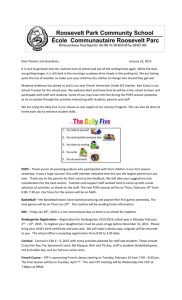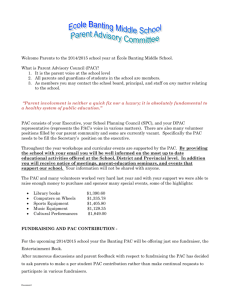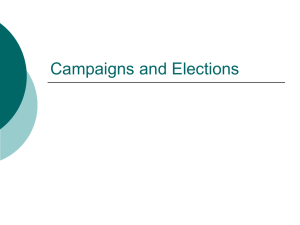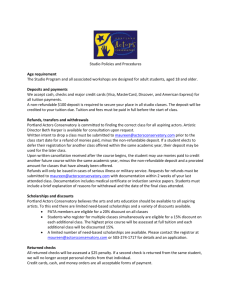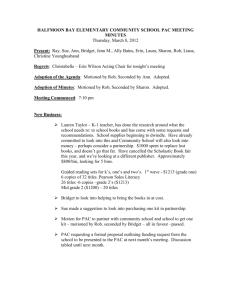docx - Jefferson Lab
advertisement
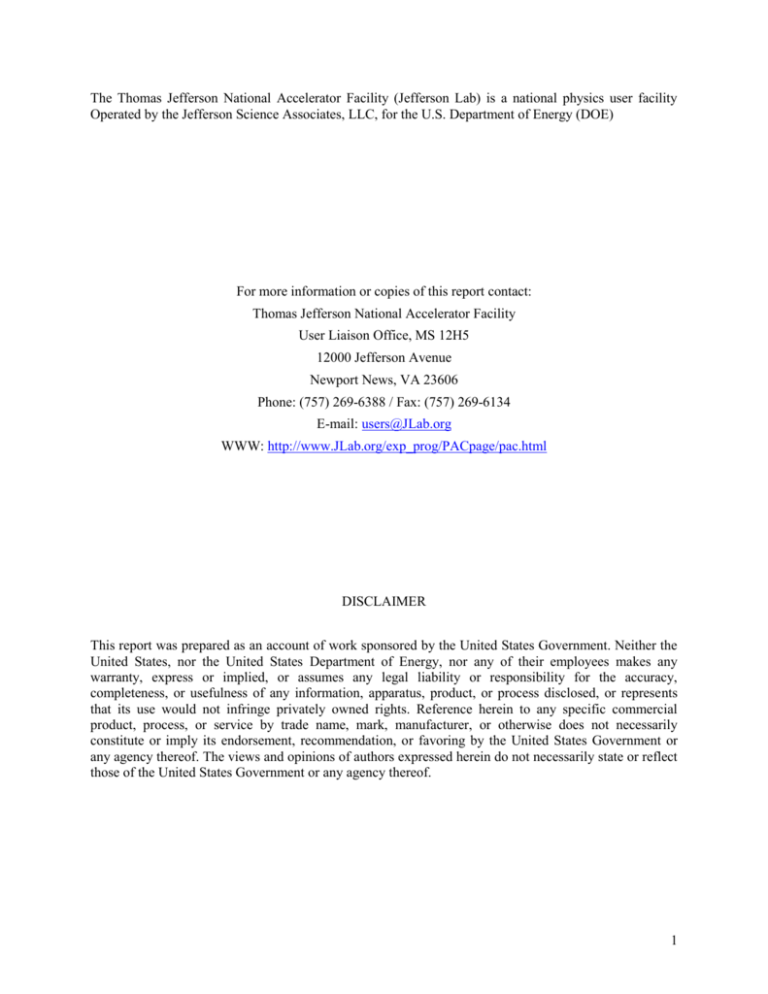
The Thomas Jefferson National Accelerator Facility (Jefferson Lab) is a national physics user facility Operated by the Jefferson Science Associates, LLC, for the U.S. Department of Energy (DOE) For more information or copies of this report contact: Thomas Jefferson National Accelerator Facility User Liaison Office, MS 12H5 12000 Jefferson Avenue Newport News, VA 23606 Phone: (757) 269-6388 / Fax: (757) 269-6134 E-mail: users@JLab.org WWW: http://www.JLab.org/exp_prog/PACpage/pac.html DISCLAIMER This report was prepared as an account of work sponsored by the United States Government. Neither the United States, nor the United States Department of Energy, nor any of their employees makes any warranty, express or implied, or assumes any legal liability or responsibility for the accuracy, completeness, or usefulness of any information, apparatus, product, or process disclosed, or represents that its use would not infringe privately owned rights. Reference herein to any specific commercial product, process, or service by trade name, mark, manufacturer, or otherwise does not necessarily constitute or imply its endorsement, recommendation, or favoring by the United States Government or any agency thereof. The views and opinions of authors expressed herein do not necessarily state or reflect those of the United States Government or any agency thereof. 1 December 22, 2010 Phone: (757) 269-7552 e-mail: mont@jlab.org Dear Jefferson Lab Users, By now, 12 GeV Project construction is well underway; we now have foundations for the new Hall D and a new Central Helium Liquefier building. Less visible on-site but important nevertheless are the numerous procurements which have been placed with industry and the detector construction which is going on at universities and laboratories across the world. The Jefferson Lab PAC continues to play a major role in the development of the scientific program for this new facility. PAC36 was the second PAC to revisit the list of approved 12GeV experiments and begin the process of assigning letter grades and beam time. The 15 experiments reviewed covered three of the six physics categories outlined by the Laboratory. The list comprised 11 approved and 4 conditionally approved experiments, whose status had been determined by previous PACs (mostly PAC30). The distribution of experiments considered by physics category was as follows: Hadron Spectra as Probes of QCD – 1 approved Longitudinal Structure of Hadrons – 5 approved, 3 conditionally approved Hadrons and Cold Nuclear Matter – 5 approved, 1 conditionally approved Sincerely, Hugh E. Montgomery Laboratory Director 12000 Jefferson Avenue, Newport News, VA 23606 • • www.jlab.org Jefferson Lab is managed by the Jefferson Science Associates, LLC for the U.S. Department of Energy Office of Science 2 Letter from the PAC Chair Foreword to PAC Recommendations PAC36 was the second PAC to revisit the list of approved 12 GeV experiments and begin the process of assigning letter grades and beam time. The 15 experiments reviewed covered three of the six physics categories outlined by the laboratory. The list comprised 11 approved and 4 conditionally approved experiments, whose status had been determined by previous PACs (mostly PAC30). The distribution of experiments by physics category was as follows: Hadron Spectra as Probes of QCD 1 approved Longitudinal Structure of Hadrons 5 approved + 3 conditionally approved Hadrons and Cold Nuclear Matter 5 approved + 1 conditionally approved The tasks with which PAC36 was charged were twofold. First, the committee was asked to review the four conditionally approved proposals in the “normal” PAC fashion. Two readers were assigned to each, a vote was taken on whether or not to approve the experiment (after committee discussion), a letter grade was assigned to the newly approved experiments, and a full proposal report was written by the primary reader. The definition of “approval” is the same as that used for all 12 GeV PACs to date: an approved experiment is one that the PAC feels is in the top half of those that should run in the first 5 years. The PAC’s second task was to assign a letter grade to the 11 approved experiments. (We note for clarity that the grading was done for all experiments in concert, regardless of their prior status.) The approved status of these experiments was not reconsidered. Instead, the committee was asked to use the grading procedure as the mechanism with which to demote (in the future running schedule) any experiments we felt were of lesser merit. Though the 11 previously approved experiments were assigned only one reader, they were discussed as extensively as the others, both before and after the spokespersons’ presentations. Unlike PAC35, which began the process of 12 GeV grading, the majority of the experiments considered by PAC36 were already approved and so did not receive a full-page report. The heart of every PAC’s work and the most important part of its output is the extensive panel discussion of every experiment. Thanks to the outstanding committees selected by the laboratory, the diligent work of the committee members, and the prompt responses provided by the experimenters to committee questions, numerous insights always arise from these vibrant debates. We felt it essential to summarize our opinions in written form for all 15 experiments. Taking the lead from Mike Pennington’s example as chair of PAC35, we decided to present our remarks in this section. In the following paragraphs I have endeavored to summarize the committee’s opinions on each proposal, with input from the proposal readers. The full reports on the conditionally approved experiments are presented in a later section. The issue of beam time allocation was another unusual feature of PAC36. As 12 GeV running is not yet imminent, no “sum rule” of total beam days to allocate was provided. Consequently, the committee did not spend the usual amount of time scrutinizing run plans and looking for days to cut. However, our summaries do include some remarks about the relative merits of certain kinematic points, targets, or other details of the proposed run plans. We have also flagged two experiments as good commissioning candidates, one each for Halls A and C. The recommendations below are grouped by physics topic. The second-level grouping by specific physics area reveals the subgroups within which experiments were directly compared with each other. 3 Quick-reference titles are provided for those experiments without names. The bullet with which each experiment is prefixed indicates the experiment’s approval status after PAC36: Previously Approved experiment Conditionally Approved experiment elevated to Approved by PAC36 Conditional Approval extended to the next PAC Topic #1 Recommendations: Hadron Spectra as Probes of QCD E12-06-102 (GlueX): “Mapping the Spectrum of Light Quark Mesons and Gluonic Excitations with Linearly Polarized Photons” Rating: A The main goal of the GlueX experiment is the study of the hadron spectrum in the light quark sector and the search for gluonic hadrons, in particular hybrid mesons. A complete mapping of the meson spectrum of conventional and exotic mesons is essential for a quantitative understanding of QCD in the nonperturbative regime. Since the approval of the original proposal, the collaboration has made considerable progress in the development of refined analysis tools which are essential for the success of the experiment. The PAC applauds the collaboration’s success in obtaining NSF “Physics at the Information Frontier” funding to build a strong group focused on amplitude analysis techniques, and to increase the computing power available for such analysis. Considerable progress has also been made in Lattice QCD calculations, which reaffirm the motivation and provide strong theoretical support to the experiment. The collaboration between the GlueX collaboration and JLab’s strong in-house lattice group is excellent. On the experimental side, the committee was very happy to see a pronounced improvement in GlueX’s manpower situation with the addition of the PRIMEx collaboration. The timeline seemed reasonable, but the PAC did not have sufficient information to evaluate it in detail (e.g., delays in the refurbishment of the spectrometer solenoid were mentioned in discussions, but not described in the presentations). The PAC is satisfied that the frequent reviews of GlueX provide ample oversight to address such details. Finally, the PAC would like to express its hope that the descoped Cerenkov detector be revisited at some time in the future. The loss of kaon identification from the current design is a real shame, but entirely understandable given the inescapable limitations on manpower, resources, and time. Due to the strength of its scientific program, GlueX is a flagship experiment of the 12 GeV upgrade with unique physics opportunities and the potential for groundbreaking discoveries. The PAC recommends the allocation of 120 days of beam time as requested by the collaboration. Topic #2 Recommendations: The Longitudinal Structure of Hadrons A. The g1 group The three experiments in this group are focused on the measurement of the quark helicity distributions Δu(x) and Δd(x) at the highest accessible values of x using polarized inclusive DIS. E12-06-109 (g1 CLAS): “The Longitudinal Spin Structure of the Nucleon” Rating: A 4 With the open geometry coverage of CLAS12 and the use of both hydrogen and deuterium targets, this experiment offers the broadest kinematic coverage and flavor sensitivity of the three g1 experiments. The broad (x,Q2) coverage will, in particular, permit important constraints on higher twist contributions up to x = 0.6. The sensitivity to the gluon polarization ΔG via QCD fitting at NLO was also impressive. The committee was delighted by the excellent progress made on the polarized targets for Hall B: after some rescoping, funding is now secured from the NSF and a detailed manpower plan was provided in the updated proposal. Finally, we note that this experiment will run parasitically with the approved CLAS12 polarized-DVCS experiments. E12-06-110 (g1n Hall C): “Measurement of the Neutron Spin Asymmetry A1n in the Valence Quark Region Using an 11 GeV Beam in Hall C” Rating: A, approved E12-06-122 (g1n Hall A): “Measurement of the Neutron Asymmetry A1n in the Valence Quark Region Using 8.8 and 6.6 GeV Beam Energies and the BigBite Spectrometer in Hall A” Rating: A– These experiments exploit the Hall A and C spectrometers to measure the down quark polarization Δd(x) at the highest possible value of x and level of statistical precision (i.e., beyond that accessible at CLAS). Their use of a 3He target also provides an important systematic check on possible nuclear effects in the extraction of Δd. PAC30 approved the Hall A experiment, but conditionally approved the Hall C experiment as it was not convinced that Hall A could not be used for the entire program. The case made at PAC30 was that the Hall A BigBite spectrometer with an added Cerenkov detector would not provide sufficient pion rejection to reach the highest x and Q2 points of the Hall C proposal. As the Hall A experiment would likely run near the start of 12 GeV data taking, it seemed sensible to simply wait and see how BigBite performed before making a final decision on the need for further data from Hall C. The updated proposals reviewed by PAC36 included numerous changes that made the two experiments much more similar. Perhaps most importantly, the beam time request for the Hall C was greatly reduced: from 79 to 36 days, which is commensurate with the 23 days requested at Hall A. Both experiments propose to take two stripes in (x,Q2) that give each a Q2 lever arm up to similar values of x (0.6 for Hall A and 0.55 for Hall C). Both have hardware issues. At Hall C, the dramatic reduction in beam time was accomplished by proposing a major upgrade of the target that would permit it to withstand a 60 μA beam current. Significant R&D will be required to accomplish this technical goal. At Hall A, a more modest target upgrade was invoked (for 30 μA maximum beam current), but the new Cerenkov detector proposed for BigBite was revealed to be a RICH with a finely segmented array of over 1,000 phototubes. The PAC was pleased to see that manpower (the Averett group) was clearly identified for this task, but even with the recycling of parts from the decommissioned HERMES RICH, this is an ambitious undertaking. With the Hall A and Hall C A1n proposals now on a near-equal footing in terms of beam time and experimental complexity, the PAC concluded that they should have equal approval status. The difference in letter grade arose from the experiments’ kinematic reach. The Hall C experiment has two small but distinct advantages in this area, thanks to its use of the full 11 GeV beam energy. First, the top x value of 0.77 is the highest of all the g1 experiments. Though this value is only slightly above the 0.70 accessible at Hall A, the PAC found Wally Melnitchouk’s arguments persuasive: the non-linear behavior of highertwist, target mass, and other corrections in the quest for the x → 1 limit of the PDFs makes a strong case for pursuing even slight improvements in x range. Second, the Hall C experiment has the broader Q2 range (2 - 8 GeV2 as compared to 2 - 5 GeV2 at Hall A), which is also important for constraining higher twist contributions. 5 B. The d/u group The PAC placed very high value on the physics case of these two experiments: the determination of the x → 1 limit of the quark flavor ratio d(x)/u(x). This is one of the 12 GeV program’s “gold-plated” measurements, as it will have a clear impact on theory and can only be accomplished at JLab-12. The PAC strongly endorsed the pursuit of both experiments in this category. They employ completely different and equally ingenious approaches to the pressing question of nuclear corrections that has limited all previous attempts to determine the x → 1 limit of d/u. E12-06-113 (d/u BONUS): “The Structure of the Free Neutron at Large x-Bjorken” Rating: A, approved This proposal deals with deuterium nuclear corrections by avoiding them. The new BONUS detector will be used to measure the recoiling proton from DIS off the neutron, and only events with very small missing momentum (70 - 100 MeV) will be used in the d/u determination. The theoretical support for neglecting nuclear corrections for nucleons so nearly on-shell was agreed to be strong. It can also be tested experimentally: BONUS will measure recoil protons up to 200 MeV, which should reveal a “plateau” in the pm region where nuclear effects vanish. Impressive results were shown from the recently collected CLAS+BONUS data as well as from the ongoing tests of the planned BONUS upgrades. PAC30’s technical condition was clearly met and the experiment was upgraded to approved status. PR12-06-118 (d/u MARATHON): “Measurement of the F2n/F2p, d/u Ratios and A = 3 EMC Effect in DIS off the Tritium and Helium Mirror Nuclei” Unrated: conditional approval continued The PAC was equally supportive of the elegant strategy of the MARATHON proposal, which will employ ratios of DIS cross-sections from the mirror nuclei 3H and 3He to minimize nuclear structure effects at high x. The PAC also supports the development of the tritium target on broader grounds, as it will no doubt enable other unique measurements at JLab. The condition imposed by PAC30 — on demonstration of the technical (and administrative) feasibility of this target — was clearly met. Not only has excellent progress been made on the design of the target, but the MARATHON collaboration greatly simplified the project by shifting a factor of 5 in its luminosity requirement from the target to the spectrometer acceptance. Pursuit of the low-activity target is an excellent strategy. However, new questions have now arisen concerning the proposed spectrometer. It is the large-acceptance SBS — now generally considered part of the 12 GeV baseline equipment — but augmented with two new components: an electromagnetic calorimeter and a RICH detector. No design of any detail was provided for either of these components. The PAC is confident that the addition of a lead-glass calorimeter will pose no particular challenge, but the addition of a RICH would be a much greater undertaking, and one with no manpower yet identified. Discussions with the experimenters made it clear that the design was still in a state of flux, and that all options from the complex HERMES-like RICH design described in the proposal to a threshold Cerenkov detector of limited segmentation were still under consideration. The possibility of doing without any Cerenkov detection was also raised: perhaps the SBS with a calorimeter and good neutron shielding is sufficient at backward angles where backgrounds are lower, while the smalleracceptance HRS might be used at forward angles where signal rate is not a concern. The PAC discussed at length how to rate the experiment given the preliminary state of the detector design. The decision was finally made to continue the Conditional Approval with a modified technical condition. The PAC wishes to stress that this decision does not reflect any negative attitude toward the experiment. The committee strongly endorses the MARATHON concept and tritium target. The decision not to change its status to some form of approval was made to avoid assigning a letter grade at this time. The committee did not wish to down-rate the experiment because of a technical issue that can clearly be resolved with more time, but could not comfortably give the experiment an “A” rating without a spectrometer design. 6 The new technical condition for approval, which is described in detail in the full report, has three key parts. (1) Clearly demonstrate the need for modifications of the SBS at both high and low x settings, as signal and background rates are very different in these regimes. (2) Quantify the experimental backgrounds, both by type and rate, and including neutron background. (3) Specify how much manpower will be required for the chosen SBS upgrades. (We do not feel that the identification of specific groups is necessary, but do feel that some measure of the resources required is essential to gauge the scope of the project.) C. Other longitudinal structure E12-06-121 (g2 Hall C): “A Path to Color Polarizabilities in the Neutron: A Precision Measurement of the Neutron g2 and d2 at High Q2 in Hall C” Rating: A– This inclusive DIS measurement of g1 and g2 at large x using a polarized 3He target is a straightforward and clean measurement. The data will enable the determination of the theoretically well-understood twist3 matrix element d2 over a range of Q2-values, a quantity that can be compared to lattice calculations. No particular complications are expected in the proposed use of a new polarized 3He target, which will need only withstand the relatively modest maximum beam current of 30 μA. This measurement is unique to JLab, as it demands both high luminosity and very high x (due to the x2 weighting of g1+g2 in the d2 matrix element). E12-06-104 (RSIDIS): “Measurement of the Ratio R = L/T in Semi-Inclusive DIS” Rating: A– This experiment will use the unique capabilities of JLab-12 to measure an observable that has been urgently needed for some time. Analyzers of all SIDIS data collected to date have had to resort to modeldependent guesses for the R ratio, typically using either zero or the values determined from inclusive DIS. As the proposal lucidly explains, RSIDIS will likely have a pronounced dependence on the z value of the measured hadron; its behaviour will help to shed light on the nature of the SIDIS process, which is particularly important at the rather modest energies of JLab where deviations from the LO factorized picture may be a significant element in the interpretation of the high-statistics SIDIS data to be collected at 12 GeV. The concern raised at PAC30 concerning the experiment’s limited ability to constrain azimuthal moments of the SIDIS cross-section was acknowledged by PAC36 but felt not to constitute a significant impediment. It is an inescapable complication in this exploratory measurement, and the committee is confident that the experimenters will identify good strategies to address it once the first data are collected. Finally the committee would like to emphasize that the A– rating does not reflect any doubt about the importance of this unique measurement, simply an honest guess that the results will likely confirm expectations and that their impact will be limited by the technical nature of the subject. E12-10-002 (F2 resonance): “Precision Measurements of the F2 Structure Function at Large x in the Resonance Region and Beyond” Rating: B+ The committee did not find the twofold physics case presented for this experiment to be particularly strong. First, by assuming that local duality holds for W2 > 3 GeV2, the proposed new F2 data in this region will be used to constrain the parton distribution functions at very high x, where they are largely unknown. The committee was not convinced that the duality assumption could be supported in an independent way, i.e. one that does not involve simply confirming the agreement of the low-W PDF extractions to those made with higher-W data. The second goal is to push tests of local duality in F2 into the regime W2 < 3 GeV2. The PAC was unclear on what exactly would be learned about QCD if these 7 tests were to fail. Instead, the committee suggests that the experimenters refocus their physics case on the admittedly more mundane goal of constraining the high-x extrapolations needed to determine the moments of F2, for comparison with lattice QCD. Particularly in the case of higher-order moments, real data at high x — which inevitably fall in the resonance region when a moment at fixed Q2 is determined — are of great value in reducing uncertainties from model-dependent extrapolations. The PAC notes that this experiment is an excellent commissioning candidate for the first data collection in Hall C: only baseline equipment is needed, and the collaboration has a long and highly successful track record in performing precision measurements of this type. Topic #3 Recommendations: Hadrons and Cold Nuclear Matter A. The color transparency group The two experiments in this group seek to establish the onset of the Color Transparency (CT) phenomenon, in different exclusive processes. The PAC had similar concerns with both experiments: the difficulty in establishing an unambiguous experimental signature of CT, and the unclear theoretical impact of the observation — or non-observation — of the phenomenon at a particular scale. These two concerns resulted in conditional approval at PAC30 of the exclusive - and p-production experiment, PR12-06-107. The exclusive -production proposal, E12-06-106, was approved at PAC30 with the written exhortation that the overlap in beam use with the hadron attenuation experiment E12-06-110 be maximized in a future run plan. E12-06-107 (CT ,p): “The Search for Color Transparency at 12 GeV” Rating: B+, approved The PAC commends the authors of this proposal for their concerted effort to address PAC30’s two concerns. First, the authors worked hard to develop a conclusive signature of CT, by studying the Q2dependence and A-dependence of the nuclear transparency simultaneously, rather than relying on the Q2dependence alone. Second, the updated document presented a thorough review of current theory. The PAC agrees that the recent work of Frankfurt, Miller, and Strikman to explain existing p, , and transparency measurements distinctly bolsters the interpretability of new data, as does work on individual channels by groups at Giessen and Gent. The PAC also concurs with the new JLab theory report that the exclusive - and (quasi-elastic) p-production channels are likely cleaner than the -production channel due to the absence of initial state effects and decay products. However, the applicability of the pQCDlike picture on which CT is based still rests on the intrinsic kT of quarks playing only a small role in hardexclusive processes. Recent work suggests that this issue may be “under control” in production, but not in quasi-elastic scattering. To address the perennial question “What would we learn if CT were not observed?”, the updated proposal argues that observing CT is a necessary pre-condition for the interpretation of exclusive production in terms of the GPDs and the handbag diagram. However, the GPD picture does not require the nuclear component of the CT prediction — i.e., the assumption that the expansion time of the scattered point-like quark configuration is longer than the time it takes to exit the nucleus. Despite these concerns, the PAC feels that there is enduring interest in CT, that the proponents of PR12-06-107 have met PAC30’s conditions as much as is possible, and that they have certainly put their experiment on an equal footing with the approved -production experiment E12-06-106. The proposal is approved, for the requested 26 days of beam time in Hall C. The proposal requests 9 and 17 days for (e,ep) and (e,e+) respectively. Only one heavy target, 12C, is proposed for (e,ep), while both 12C and 63Cu will be used for (e,e+). The PAC supports the concentration of resources on the (e,e+) channel and found the argument for two targets very persuasive, but was concerned by the projected precision for 12C(e,e+) vs Q2. Given the plot shown in the updated 8 proposal, there is a strong possibility that this measurement will be statistically inconclusive. The PAC urges the experimenters to consider allocating yet further resources to this channel, perhaps at the expense of (e,ep). E12-06-106 (CT VM): “Study of Color Transparency in Exclusive Vector Meson Electroproduction off Nuclei” Rating: B+ This proposal requests 60 days of beam time in Hall B to measure the nuclear transparency for (e,e) production from Cu, Fe, and Sn targets. Deuterium target data would be collected simultaneously. The PAC’s physics concerns with this experiment are essentially the same as those for E12-06-107, with the complication of intrinsic quark kT in (e,e) replaced by the complications of coherence length effects and ISI in (e,e). This experiment was approved at PAC30. At PAC30, 40 days of beam time were requested for “CT VM” (E12-06-106), and the impression from discussions was that much of that time could run concurrently with the “hadron attenuation” experiment E12-06-117 with some coordination effort from the two groups. At PAC36, a very different picture was presented. “CT VM” increased their request to 60 days, “hadron attenuation” dropped their request from 100 to 60 days, and neither experiment showed any point of overlap with the other. The PAC36 committee realizes that the total number of days has been kept roughly constant, but does not support this rearrangement. Unlike PAC30, this PAC had the opportunity to assign letter grades and thereby rank the relative physics impact of the experiments. The committee found the “hadron attenuation” physics case considerably stronger than that for “CT VM”, and did not feel that “CT VM” on its own merits a full 60 days. We appreciate the difficulty of coordinating magnet polarities and triggers between experiments with different final states, but at the very least, the issue of targets can be addressed. PAC36 agreed that the Sn target should be abandoned in “CT VM”, as the predicted effect — which scales as A1/3 — is not significantly different in Sn than it is in Fe. The beam time allocated to Sn would be much better used to increase the statistics on C, for example, to give a better description of transparency vs Q2. As described below, “hadron attenuation” must also address its list of targets, which presently has no overlap with “CT VM” as it is simply the list of HERMES target gases used for projections. The committee is very hopeful that the experimenters’ ingenuity will yield a run plan with significant overlap between these two CLAS experiments, both on the nuclear dependence of hadron production. B. The short-range correlations group The following three experiments share the study of short-range N-N correlations within nuclei as key elements — but not the only elements — of their physics cases. The PAC considers this physics compelling. Although it is not yet clear that theory can directly connect these studies to the short-range part of the N-N interaction, the two are obviously related, and studies such as these may offer one of the few remaining routes to improving our knowledge of the N-N interaction in this corner of abiding uncertainty. E12-06-105 (x > 1): “Inclusive Scattering from Nuclei at x > 1 in the Quasi-elastic and Deepinelastic Regimes” Rating: A– E12-10-008 (EMC high-x): “Detailed Studies of the Nuclear Dependence of F2 in the Light Nuclei” Rating: A– 9 The PAC had a very similar impression of these two experiments: both are top-quality experiments whose design reflects impressive insight into the SRC area. Both experiments involve compelling observables that will provide qualitative new information on short-range correlations in nuclei. For example, the “x > 1” experiment (E12-06-105) will seek to establish or refute the existence of a second plateau at x > 2.2 in the A/D ratio, hints of which have been observed in previous JLab data. Such a plateau would provide a dramatic signature of 3-body correlations at work and valuable information on their strength and isospin dependence. The committee was equally fascinated by “EMC high-x” (E12-10-008) and the ingenious suggestion of a connection between the EMC effect and the local density of nuclear matter, supported by similarities in their A-dependence and isospin-dependence. The PAC enthusiastically supports the full beam requests of both experiments: 32 and 23 days for E12-06-105 and E12-10-008 respectively, both in Hall C. E12-10-003 (pm ≫300 MeV): “Deuteron Electro-Disintegration at Very High Missing Momentum” Rating: B+ This experiment addresses two fundamental questions in nuclear theory: the behavior of the N-N wave function at small distances, and the transition from nucleonic to quark degrees of freedom. It will measure the d(e,ep) cross section for missing momenta (pm) from 500 MeV to 1 GeV, doubling the current range. The chosen kinematics minimize the contribution of final state interactions and should provide information about non-nucleonic degrees of freedom at large missing momenta. While the PAC was concerned about the interpretability of these data given the current state of theory, it believes that the data are essential to constrain further theory developments. Overall the experiment was viewed very highly; the lower rating simply reflects the likelihood that the data will not reveal any particular surprise and that their impact may thus be limited to experts in the field. As standard Hall A equipment is used, and as the experiment poses no special difficulties, it would be an excellent commissioning candidate for the early stages of 12 GeV running. The PAC debated the need for all 21 requested days, specifically the 6 required for the highest pm kinematic setting. It is impossible to gauge the importance of this setting until the data themselves are collected, and reveal a surprise or not. However, if the experiment were to run as a commissioning experiment, the inevitable commissioning overhead would render moot a debate over 6 days. C. The hadron attenuation group E12-06-117 (hadron attenuation): “Quark Propagation and Hadron Formation” Rating: A– The proposed series of experiments is devoted to the study of mechanisms of confinement. These experiments will use a variety of nuclear targets to resolve the space-time structure of hadron production and formation in deep inelastic electron scattering on nuclei. These measurements will enable a new level of refinement in models of hadron formation and attenuation in cold nuclear matter — models that are not only interesting in their own right, but also of considerable importance to the heavy ion community. The collaboration presented a document that illustrates new developments achieved over the past four years, both experimentally and theoretically. The main experimental developments are further analyses of the HERMES data and of the CLAS EG2 data. The latter clearly demonstrate the feasibility of the measurements proposed; at the same time, they show the considerable improvements that will come from the 12 GeV data in terms of the broader Q2 coverage and the larger selection of nuclear targets to adequately constrain the A-dependence. Considerable progress has also been made in the theoretical 10 understanding of the experimental data, and its interpretation in terms of distinct hadron production and formation times. The PAC congratulates the collaboration for focusing their proposal on observables binned in multiple kinematic dimensions: therein lies the qualitatively new information that JLab-12 is uniquely able to provide. In addition the collaboration presented several promising and interesting new ideas in the updated proposal, in particular the study of multi-hadron final states, photon-hadron correlations, and the extraction of space-time information from HBT/Bose-Einstein correlations. The new developments and new ideas presented in the update document add to the scientific interest of the original proposal, making it even more relevant and urgent. The PAC recommends the allocation of 60 days of beam time, as requested by the collaboration. However, the PAC strongly urges this collaboration and that of the “CT VM” experiment (PR12-06-106) to develop a run plan in which targets, CLAS magnet settings, triggers, and other aspects of the experiments are coordinated to maximize the time during which they can run concurrently. The choice of “hadron attenuation” targets (which still coincides with the target gases used at HERMES) has yet to be studied at any level of detail. Acknowledgments The Jefferson Lab PAC is a remarkable institution. No committee assignment is as invigorating, inspiring, or educational, and it is an honor to participate. I am deeply impressed by the creativity and insight consistently displayed by the JLab user community. The quality of the proposals is outstanding, and the richness of the laboratory’s physics program is a source of inspiration. I extend my sincere thanks to all the committee members for their expertise, their insight, their tireless work, and their delightful good humor throughout the long hours of deliberations. On behalf of the entire committee, a big thank you to Rachel Harris, as always, for her flawless organization of every meeting and her willingness to help with every detail: badges, rental cars, forms, internet access, you name it! The committee also extends its gratitude to the PAC36 rapporteurs, the hall leaders, Larry, and Mont. We are keenly aware of the time it takes to prepare such masterful overview presentations; please know how deeply they were appreciated and how very useful they were to our deliberations. We extend our gratitude as well to Bob McKeown, Dennis Skopik, and John Domingo for their tireless availability to answer our questions. Finally, I offer my heartfelt thanks to Larry Cardman, the architect of the wonderful workshop that is the JLab PAC. Thank you, Larry, for your wisdom and guidance over the years, and for the saintly patience you have shown to a new PAC chair who has managed to demolish all previous records in tardiness in preparing this report. Penny Sigler, who dispenses compliments with the frequency of a blue moon, called you the “best person she’s ever worked for”. The reasons are perfectly plain. Naomi C.R. Makins Chair, Jefferson Lab Program Advisory Committee 11 APPENDIXES A. PAC 35 Membership B. Charge to PAC 35 C. Individual Reports for Conditionally Approved Experiments 12 Appendix A: PAC36 Members NAOMI MAKINS (Chair) University of Illinois 401 B Ioomis, MC 704 1110 W. Green Street Urbana, IL 61801 Phone/Fax: 217-333-7291/217-333-1215 gnome@jlab.org WILLLIAM MARCIANO Physics Department Brookhaven National Lab Upton, New York 11973 Marciano@bnl.gov Tel. 631-344-3151 REINHARD BECK University bonn Physikalisches Inst. Nassallee 12 D-53115 BONN, GERMANY Phone/Fax: 49-228-732341/737869 beck@hiskp.uni-bonn.de ZEIN-EDDINE MEZIANI Temple University, Philadelphia, PA 1900 N. 13th St. Philadelphia, PA 19122-6082 USA Phone: 215-204-5971 meziani@jlab.org PIET MULDERS NIKHEF Natl. Inst. For Nuclear & HEP PO Box 41882 1009 DB Amsterdam NETHERLANDS Phone: 31-20-5922000 Fax: 31-20-5925155 pietm@nikhef.nl WITOLD NAZAREWICZ Department of Physics & Astronomy University of Tennessee, 401 Nielsen Physics Knoxville, TN 37996, USA DIEGO BETTONI Istituto Nazional de Fiscia Nucleare 44100 Ferrara, Italy Italy Phone/Fax: 39532760022/39532762057 bettoni@fe.infn.it NICOLE D’HOSE Centre d’Etudes de Saclay (CEA-Saclay) Orme des Merisiers F-91191 Gif-sur-Yvette Cedex FRANCE Phone: +33(0)1-6908-7385 Fax: +33(0)1-6908-8120 Nicole.dhose@cea.fr HAIYAN GAO Duke University, Durham, NC Box 90305 Duke University DURHAM, NC 27708 Phone: 617-258-0256 gao@tunl.duke.edu Physics Division Oak Ridge National Laboratory Bldg. 6025, MS6373, P.O. Box 2008 OakRidge, Tennessee 37831 Tel: 1-865-574-4580 Fax: 1-865-576-8746 witek@utk.edu EWA RONDIO Soltan Inst. For Nuclear Studies PL-05-400 OTWOCK-SWIERK, POLAND Phone: 22-7798948 Fax: 22-7793481 Ewa.rondio@cern.ch 13 EMLYN HUGHES Columbia University Physics Department 718 Pupin, Box 15 538 W 120 St. NEW YORK, NY 10027 Phone: 212-854-0796 EWH42@columbia.edu 14 HANS STROHER Forschungszentrum Jülich Institut für Kernphysik D-52425 Jülich Phone: +49-2461-61-3093 Fax: +49-2461-61-3930 h.stroeher@fz-juelich.de Appendix B Charge to PAC36 1. Review proposals that were previously conditionally approved in one of the three categories to be given scientific ratings and beam time recommendations at this PAC (“The hadron spectra as probes of QCD”, “The longitudinal structure of the hadrons”, and “Hadrons and cold nuclear matter.”). Recommend approval for those that are considered to be in the upper half of the scientific priorities for the first five years of running of the Upgrade 2. Provide Scientific Ratings and Beam Time Recommendations for the Previously Approved 12 GeV Experiments (including those approved following the first charge element) in the categories: “The hadron spectra as probes of QCD”, “The longitudinal structure of the hadrons”, and “Hadrons and cold nuclear matter.” The grading should be consistent with the “scale” used for the scientific priority setting for the 6 GeV program 15 Appendix C: Individual Reports for Conditionally Approved Experiments Individual Proposal Report Proposal: E12-06-107 Scientific Rating: B+ Title: The Search for Color Transparency at 12 GeV Spokespersons: D. Dutta, R. Ent Motivation: Color transparency (CT) was first proposed by Mueller and Brodsky in the early 1980s. Its observation would give direct evidence for hadrons fluctuating to a smaller size (point like configuration of transverse size r ~ 1/Q) and thus having reduced attenuation interactions while passing through the nuclear medium due to the cancellation of the color fields of the quarks (as with small dipoles in QED). CT remains a QCD phenomenon worth confirming, and we need solid experimental confirmation. This experiment aims to determine the nuclear transparency of protons and + mesons by measuring the cross section of the reaction A(e,ep) at 8 < Q2 < 16 GeV2 and of the reaction A(e,e+) at 5 < Q2 < 9.5 GeV2. These measurements are extensions of earlier experiments at JLab. The previous A(e,ep) experiment excluded a sizable CT effect for protons up to Q2 < 8 GeV2, while this extension to 16 GeV2 will perfectly overlap with the kinematics of the BNL A(p,2p) experiment where a rise in transparency was clearly observed. The A(e,e+) measurements will cover a range from Q2 = 6 GeV2, where the possible onset of CT was already seen in the previous experiment, up to about Q2 = 10 GeV2. Unambiguous confirmation of the CT effect can help to verify the strict applicability of the factorization theorems for pion production. Using pions and protons in the final state may be cleaner than rho mesons, because of other mechanisms interfering in the latter case. The three measurements taken together will provide a comprehensive view of CT. Measurement and Feasibility: Measurements of CT are proposed in the reactions A(e,ep) on hydrogen and carbon targets and in the reaction A(e,e+) on hydrogen, deuterium, carbon and copper targets. The experiment would be performed in Hall C using the HMS and new SHMS spectrometers with a non-standard aerogel counter in the detection package. The beam current would be 80 μA, and the targets would include 15 cm long LH2 and LD2 targets, as well as 6% radiation length 12C and 63Cu solid targets and a 2.5% radiation length 12C target to control radiative corrections. Issues: In the theory report on the original (2006) proposal, a remark was made on theoretical progress (“... but further theoretical progress is needed to interpret the results”). In the meantime several theoretical predictions have been completed, and one of them (Frankfurt, Miller, Strikman) can reproduce perfectly all the observed data in A(e,ep), A(e,e+) and A(e,e). We can cite also Cosyn, Ryckebusch et al. who give prediction for CT of proton and pion, and recently in 2009 Kaskulov, Gallmeister and Mosel for CT on pion production. The calculations agree on the expected behavior in Q2 and A. The PAC stresses the importance of precise measurements in the difficult quest for an unambiguous CT signal, and so recommends rebalancing the 26 days to improve the statistics on 12C(e,e) to get the best description of the evolution in Q2. 16 Recommendation: Approval 17 Individual Proposal Report Proposal: PR-12-06-110 Scientific Rating: A Title: Measurement of the Neutron Spin Asymmetry A1n in the Valence Quark Region Using 11 GeV Beam and a Polarized 3He Target in Hall C Spokespersons: J-P.Chen, G.D. Cates, Z. E. Meziani, X. Zheng (contact person) Motivation: The main goal is to measure precisely the neutron spin asymmetry at high x in the DIS region. The experiment will cover 0.3 < x < 0.77, where large uncertainties presently exist. The proposed setup allows for a Q2-dependence study at values of x up to 0.55, which is intended to be performed in combination with measurements approved in Hall A. These A1n measurements, when combined with similar data on proton asymmetries will allow for a flavor decomposition of the polarized structure functions. In particular, our knowledge of d/d needs improvement at high values of x. For the point at x = 0.77, the proposed precision will be sufficient to distinguish between two dramatically different predictions for d/d in the limit x1: one from perturbative QCD where d/d approaches 1, and the other from the constituent quark model (CQM) where it remains negative at high x. The influence of orbital angular momentum (OAM) can possibly be checked by comparing the results at the highest x with expectations from models with and without OAM contributions. Measurement and Feasibility: The luminosity of this experiment has been increased by a factor of 8 compared to the original proposal. This is due to improvements in the polarized 3He target. The kinematic coverage allows for Q2dependence studies by combining the data from Hall A and Hall C experiments up to x = 0.55. This measurement features very good suppression of background from charged pions as well as from 0 decaying to e+e–. The measurement of A1n is important enough to warrant the pursuit of two approaches characterized by very different systematic uncertainties. The closed spectrometer allows for a measurement with better control of background systematic. With the improved luminosity the measurement requires 35 days of beam, including additional measurements in resonance region. Issues: The R&D required to realize the proposed 3He target is a challenging endeavor, but will allow the use of 60 A beam current on target. Recommendation: Approval 18 Individual Proposal Report Proposal: PR12-06-113 Scientific Rating: A Title: The Structure of the Free Neutron at Large xBjorken Spokespersons: S. Bueltmann, S. Kuhn, H. Fenker, W. Melnitchouk, M.E. Christy, C.E. Keppel, V. Tvaskis and K. Griffioen Motivation: The behavior of the ratio F2n/F2p of proton to neutron spin-independent nucleon structure functions in deep-inelastic scattering (DIS) is poorly known at very large x due to the large uncertainty in the nuclear corrections required to access F2n using deuterium. To definitively establish the trend of this important ratio as x tends to unity, it is proposed to minimize the effect of the nuclear corrections by ensuring that DIS occurs on an almost on-shell neutron. This is achieved by tagging the slow recoiling proton (of about 70-100 MeV/c momentum) from the electro-disintegration of the deuteron in the backward hemisphere of CLAS12. The d/u parton distribution ratio will then be determined at large x within the quark-parton model with a precision capable of discriminating between constituent quarks models and pQCD predictions using current quarks. Measurement and Feasibility: It is proposed to measure the 2H(e,ep)X reaction in the DIS region for Q2 > 1 (GeV/c)2 using the CLAS12 detector in combination with an upgraded RTPC to detect recoiling protons with slow momenta ps < 100 MeV/c and large recoil angles pq 1100. This measurement is a natural extension of the successful BONUS experiment (E03-02) that demonstrated the feasibility of this elegant experimental technique. The proposed measurement will reach a value of x = 0.8 with a stringent W ≥ 2 GeV cut, but would have data at higher values of x in the resonance region. The upgrade of the RTPC and associated electronics are crucial to achieve, on the one hand, the resolution necessary to minimize the accidental background at the proposed luminosity for this experiment and, on the other hand, to reach the statistical uncertainty commensurate with the physics goals at the largest possible x. Issues: With the successful completion of the BONUS analysis and the confirmation of the method as a viable technique to access the neutron structure with minimal nuclear corrections, the PAC sees no issues at this time. Recommendation: Approval 19 Individual Proposal Report Proposal: E12-06-118 Scientific Rating: n/a Title: Measurement of the Fn2/ Fp2, d/u Ratios and A=3 EMC Effect in Deep Inelastic Electron Scattering Off the Tritium and Helium Mirror nuclei Spokespersons: J. Gomez, R.J. Holt, G. G. Petratos (Contact), R. Ransome Motivation: The collaboration proposes to carry out a precise measurement of the ratio of Fn2/ Fp2 at deep inelastic kinematics (x = 0.2 to 0.83) using tritium and helium mirror nuclei to reduce uncertainties due to nuclear effects. The ratio of d/u at medium and large x values will be extracted from the data to test various model predictions of this ratio at large x. Furthermore, the A=3 EMC effect will be studied with measurements off helium and tritium at the same kinematics to allow for more stringent tests of various theoretical calculations of the EMC effect. This is one of the flagship experiments driving the original scientific case for the 12-GeV energy upgrade of CEBAF. Measurement and Feasibility: The proposed experiment was conditionally approved by PAC30 with the condition that a safety review of the tritium target be carried out by the laboratory. A review took place in June 2010. The proposed experiment will employ a room-temperature tritium target with a moderate pressure of 6.25 atm (activity of 1000 Curie). The finding of the safety review committee for the new design concept is that there is no show-stopper for the proposed target design. However, a significant amount of work at many levels, particularly on the engineering side, will be needed in the next stage of the target design. To recover the loss of luminosity due to the use of a low activity tritium target, the experiment is now being proposed using the large-acceptance Super BigBite Spectrometer (SBS). This is a different and new spectrometer setup compared to what was originally proposed to PAC30 with the use of the well characterized HRS spectrometers. In this proposal, one of the HRS spectrometers will be used to carry out the L/T separation measurements at selected kinematics to determine the longitudinal-to-transverse photoabsorption cross section ratio, R. While the idea of using the SBS for this inclusive experiment is very promising, a number of detector/spectrometer related technical aspects have not been addressed to a level that convinced the committee that the physics outcome of this important experiment would not be compromised due to this major change. 20 This is the first inclusive experiment that was proposed using an open-geometry SBS spectrometer. The proposed luminosity for the helium polarized target is about 4x10 36/cm2/s, which is about a factor of 4 compared to what ran previously using the polarized 3He target and the BigBite spectrometer in Hall A. Backgrounds need to be simulated carefully. The exact configuration of the SBS system is not specified, e.g. the distance assumed from the target to the front of the magnet for the angles between 20° and 30°. This makes it unclear whether the L/T separation with the HRS-R can be run in parallel. No specifications are given of the scattering chamber, the Cerenkov detector or of the scintillator trigger planes (and the need thereof). Simulations about the performance of the Cerenkov detector will be helpful given the open geometry environment. Demonstration of sufficient particle identification capability for all proposed kinematics of the experiment. Three non-standard energy settings are requested. Issues: While the committee has no doubt that the proposed science is first class and that the proposed experiment will be a flagship experiment of the 12 GeV program at JLab, it is not ready to approve it with an A ranking at this time given the insufficient information presented on the design of the SBS detector package for this particular measurement. The committee asks that the proponents of the experiment present at the next PAC a significantly developed spectrometer for the proposed experiment, particularly in the case of the Cerenkov detector, present simulation results on the background for the proposed luminosity, and demonstrate sufficient particle identification as well as discuss the human power for this experiment. Recommendation: Conditional Approval 21


